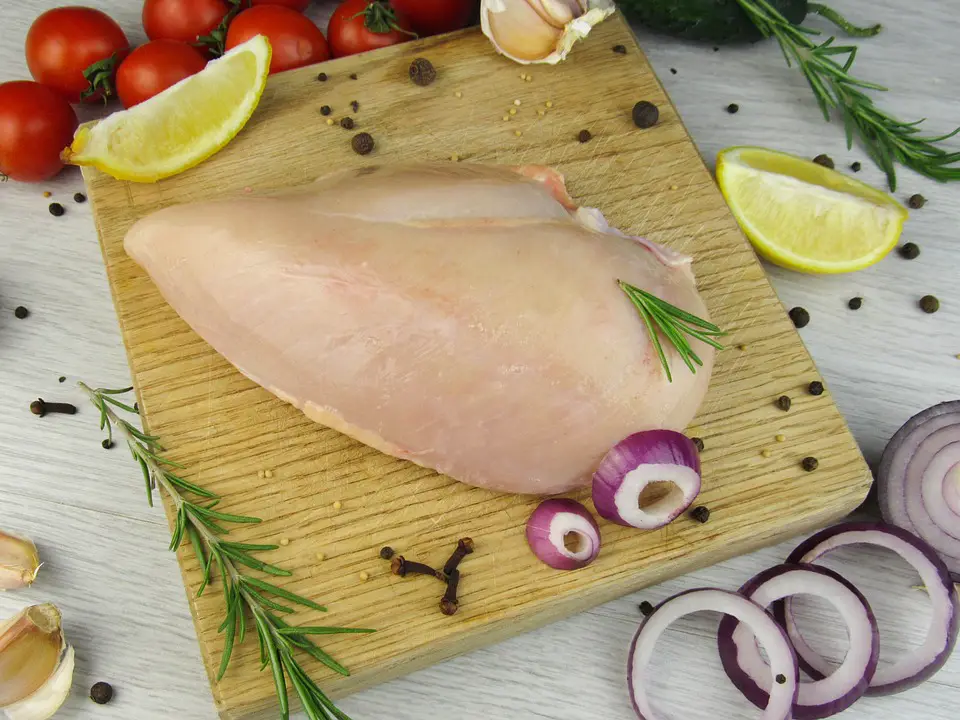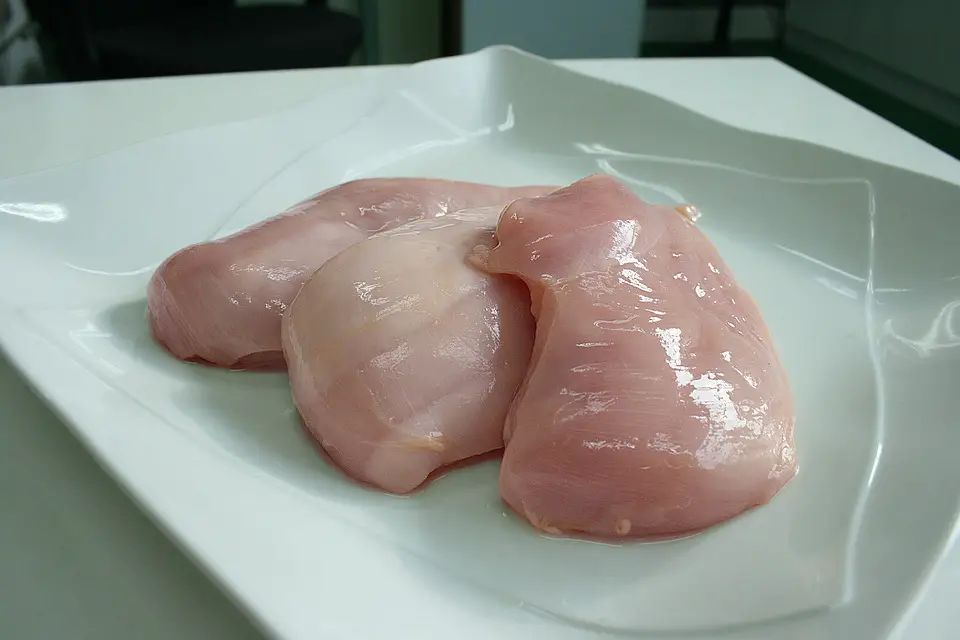Follow these easy methods to quickly defrost a boneless, skinless chicken breast in less than 30 minutes when you’re ready to make a tasty chicken meal, but your chicken breast is still a frozen brick.
Here are a few things to bear before discussing the bathing technique. Start with somewhat thin chicken breasts. You don’t want anything thicker than an inch or so for quick thawing. Your skinless, boneless chicken breasts should be sealed in a Ziploc bag (no waterlogged chicken allowed). OK, we’re all set. Let’s defrost!

What is Chicken Breast?
The pectoral muscle on the bottom of the chicken is where the lean chicken breast is removed from. Each complete chicken has one breast with two parts; the individual breasts are usually removed during the butchering process and sold separately. Compared to chicken thighs, wings, and drumsticks, boneless chicken breast meat is the most expensive chicken cut due to its desired white meat and health advantages.
This adaptable cut can be prepared in various ways, including grilled, baked, roasted, fried, barbecued, and boiled. Chicken should always be handled carefully, regardless of the cooking method, and any surfaces, utensils, or hands that come into touch with raw chicken should be well-cleansed with soap and hot water.
How to Quickly Thaw Chicken Breasts?
1. In the Fridge
The safest and most suggested method for defrosting chicken is in the refrigerator, though it might take a little longer. If you want to do this, prepare ahead and keep track of how long your chicken has been thawing.
Put the chicken in a sizable sandwich bag with a tight seal.
Sit on a plate or bowl with a lid to prevent juices from dripping onto other food and ruining it.
For best results, leave the dish in the bottom of the refrigerator overnight or for around 5 hours per 450g.
This method of defrosting chicken allows you to preserve it in the refrigerator for up to 24 hours before using it.
2. In Water
The quickest and easiest way to thaw chicken is in cold Water. There are a few critical actions to take:
Put your chicken in a sandwich bag with a tight closure so that Water can’t seep in and taint it.
Put the bag in a sizable mixing bowl or clean dishwater.
Place the bag in the basin of cold water when filled. Ensure the Water is cool; using warm or hot Water can be hazardous and encourage the growth of bacteria in the birds.
The Water is changed every 30 minutes.
The time it takes for the chicken to defrost may vary depending on how much you are using. Five hundred grams of chicken will defrost in about an hour, but be sure to check your chicken and, if it hasn’t defrosted after that time, continue with the method. Cook the chicken immediately after defrosting.
What is the Correct Method of Freezing Chicken Breast?
For safety reasons, the chicken breasts in the grocery store container don’t need to be removed before freezing. Repackaging is preferable, though, for flavor and to preserve the moisture in the chicken breasts.
To eliminate air from the packaging and heat-seal the bag’s edges, vacuum-sealing with a device (such as FoodSaver) is the ideal at-home packaging technique. No device? Still, you have choices. Chicken breasts should be put in freezer bags; before zipping the bags shut, manually remove as much air as you can.
The USDA recommends wrapping the container in aluminum foil, plastic wrap, or freezer paper if you intend to keep the chicken in its original packaging. Doing so creates a barrier between the chicken and freezer air.
The main objective is to prevent freezer burn, which can occur when chicken is exposed to freezer air and turns dry and oxidized. It’s acceptable to clip off any freezer burn patches from frozen chicken breasts after they’ve thawed. However, discard it if the entire breast appears leathery and grey.
How Long does Chicken Breast Last in the Fridge?
Refrigerate chicken breasts that are still uncooked. The refrigerator’s cool environment will prevent bacteria from forming on raw chicken. If kept in the fridge, the meat must be consumed within two to three days of purchase, according to experts, in The Ultimate Shelf Life Guide.
Raw chicken breasts should be kept in a bottom drawer or on the lowest shelves. As a result, there will be less likelihood of raw meat juices dripping onto uncooked veggies. Before using the meat, please don’t open the packaging; otherwise, store it in an airtight container. Bon Appetite claims that storing chicken in the refrigerator’s coldest section is another good idea.
The UK Food Standards Agency recommends a temperature range of 32 to 41 degrees Fahrenheit for this location, which is on the lowest two shelves.
To store chicken breasts for a long time, freeze them. According to experts, chicken breasts keep well in the freezer for nine months. After being purchased, the meat has two to three days to be frozen before it spoils in the refrigerator. Place in an airtight container, such as a freezer bag, plastic container, or tin foil. It’s simple to add frozen cubes of cooked chicken to stews and soups.
How to Identify Whether Chicken Breast is Cooked Properly?
Even if you don’t have a thermometer, several cues will tell you if the chicken is thoroughly cooked. One of the simplest methods to tell if the meat is thoroughly cooked is to look at the color of the fluid from the bird. Where the meat is the thickest, pierce it, and then look at the color of the juice that comes out of the cut. If the juice is clear, the chicken meat has finished cooking. Chicken is deemed to be done when the fluids flow clear and the meat is no longer pink when pierced with a knife or fork.
In America, chicken is the most popular meat to eat. While eating raw chicken may be a healthy choice, it can also be contaminated with the pathogens Salmonella, Clostridium perfringens, and Campylobacter. Insert your food thermometer into the thickest part of the chicken (for a whole chicken, that would be the breast). The chicken is considered cooked when the thermometer reads 180°F (82°C) for a whole bird or 165°F (74°C) for chicken parts. You risk getting food poisoning if you eat chicken that isn’t cooked through.
What are the Different Varieties of Chicken Breast?
You can buy chicken breasts that have already been trimmed and are prepared for usage. Many supermarket stores and bulk warehouses carry frozen, individually wrapped chicken breasts. Check the nutrition information label if you purchase one of these practical options. These chicken breasts can contain more salt than usual. Additionally, chicken may have labels that state that it is organic, antibiotic-free, or similar. The US Department of Agriculture (USDA) is in charge of these terminologies:
According to the agency, “Producers must show the Agency that the poultry has been provided access to the outside.”
Natural: “A product with minimal processing and no added colouring or artificial components.” The label must define the phrase “natural” (such as “no artificial ingredients; little processed”). A processing technique referred to as “minimal processing” does not considerably alter the final product.
Hormones are not allowed to be used to raise poultry or pigs. As a result, the line “Federal rules prohibit the use of hormones” must be included with the claim “no hormones added” on a pig or chicken labeling.
“If the producer furnishes the Agency with acceptable paperwork proving that the animals were not raised with antibiotics, the terms’ no antibiotics added; may be used on meat or poultry products labels.”
To be marketed as organic, chickens must be raised and cared for by strict regulations. For instance, they have to consume only organic food.
How to Identify Whether Chicken Breast has Gone Bad?
Smell
A sour chicken ought to smell distinctive. Fresh raw chicken has a light aroma that is not overpowering. If not sour chicken, it will smell funny, like rotting eggs. Additionally, it must taste sour. To avoid confusion, always verify the label. How much of a difference a fresh chicken can make to your lunch will astound you.
There are further indications of rotten chicken besides the smell. While decaying chicken will have a fishy odor, the meat will be sticky and difficult to digest. The skin of the bird will also have a bad odor. It may have black or white patches and a sour taste. Whether the skin is white or black, it’s spoiled. A pale pink color is another sign of spoiled poultry.
Color
The chicken is probably not fresh if it is green or grey. These characteristics cause the meat of a chicken to smell bad. Chicken with yellow or brown skin has likely been spoilt. The chicken needs to be smell-free and solid. It’s fresh whether it’s white or pink. It’s rotten if not. It is unpleasant if anything smells fishy.
Odor
The stench is strongest when it comes to the smell of rotten chicken. A rotten chicken breast will have a foul odor. The flavor of your meals will be improved by using a chicken with a pleasant fragrance. Therefore, looking at the best-by date is the best approach to determine whether a chicken is spoilt. A product with a better aroma won’t smell fishy, and the meat is not fresh.
What are the Side Effects of Consuming Chicken Breasts?
Cholesterol Level
Blood cholesterol levels are raised by eating meat and other animal-based foods like chicken. Low-density cholesterol, which is unhealthy and can lead to cardiovascular disease, is present in chicken. Recent studies have shown that consuming a lot of saturated fat in chicken can raise the amount of low-density cholesterol. Let’s discuss how chicken raises cholesterol.
Not Safe
There are various issues with consuming non-vegetarian meals. According to certain studies, they are pumped with antibiotics and other chemicals, which only accelerates their 45-day growth. According to a recent study, three weekly servings of chicken are equivalent to three antibiotic injections. For the birds to grow more quickly, poultry farms feed them a lot of vitamins and minerals, which may not be the best strategy. Additionally, the protein is merely chicken and lacks nutrition because of the fast growth.
Conclusion
If you have frozen chicken, you want to defrost it safely. You can do this in a microwave or on your stovetop. However, it is important to follow some tips for safe defrosting chicken breasts.
First, you must be careful to remove any ice crystals on the chicken’s skin. You should also check its temperature. It should be no less than 165 degrees Fahrenheit. Chicken not properly defrosted may become rubbery and not taste very good. Once your chicken is properly thawed, it is time to cook it. Keep in mind that you will need to check it at regular intervals. For example, you should flip it over halfway through its cooking time. This will help ensure that it is cooked through and defrosted evenly.

